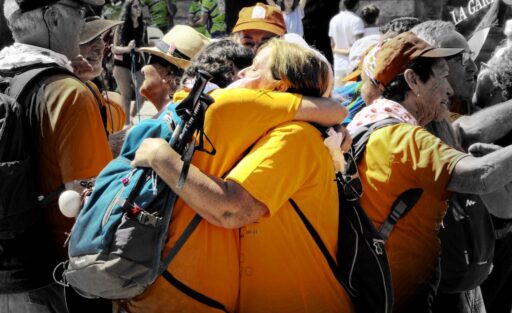
Mostly plastic, mainly good was how the Chinon CE-5 camera was described by a review at the time. Here’s my take on it 40 years after it launched.
More forgotten then even the Nikon F-301(which I happen to love) the Chinon CE-5 is definitely a last place hero though in fact in its day one of the very first cameras to ever be able to manage Auto Focus a feat which eluded many of the bigger makers. In part the AF may have doomed it. A savvy buyer, back in the balmy days of 1981, when the CE-5 launched may well have reasoned that if the big boys like Pentax, Canon, Minolta and Nikon have all fallen flat on their faces trying to make Auto Focus work why trust a no-name to get it right.
The three small contacts that appear on the upper left side of the lens mount were there to facilitate operation with an AF lens sold as an extra. Chinon only ever made two AF lenses for this. A standard 50mm and a 35mm-70mm Zoom. Both are now so rare I spent three years seeking one without any luck at all. The lenses are big, bulky and dwarf the camera.
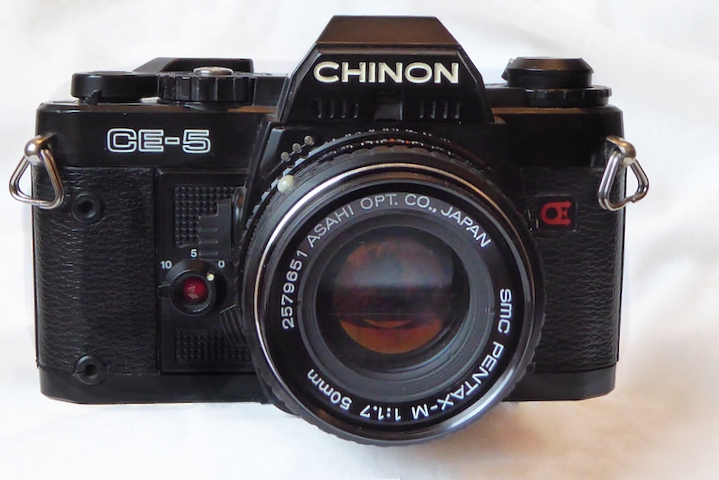
The Chinon CE-5 was only in production for about 12 months and had the disadvantage in the UK market, along with every other Chinon, by being exclusively sold by Dixons. A high street chain with a reputation for goods of dubious quality and often shockingly cheap and shabby. As a result I doubt Chinon ever really got any serious photographers attention and were generally seen as cheap wannabees. That’s a real shame as their build quality is often superb and functionally the cameras work extremely well the CE-5 is no exception.
So lets have a look at the Chinon CE5 –
- It featured a Seiko Electronic Vertical Metal Bladed shutter – quite some improvement over most budget cameras with their cloth horizontal shutters. The CE-5 uses a stepless shutter for its Aperture Priority (AP) mode with speeds from ‘B’ to 2000th – few cameras from this period would run over 1000th.
- Exposure compensation for the AP mode up to 2 stops – it’s a little odd they way they implemented it but it’s there plus an exposure lock function which Chinon called Exposure Memory.
- A power winder/motor drive option that allowed the camera to be fired off the power winder grip even with no batteries in the winder. Adding the power winder made the camera very comfy to hold and with no batteries added little weight.
- One of the best Depth of Field Preview (DoF) controls I have ever used. Only the Canon FTb has a better and more conveniently placed one in my experience.
- Slick controls, well placed, no annoying on/off switch (the bane of my life with Minolta X-x00 series. The on/off switch is located on the shutter speed dial. If it’s off it’s off, if you have selected a shutter speed its on.
- Smooth winder action that would give Minolta a run for their money and a better viewfinder than anything except the Minolta with their AcuMatte screens. The CE-5 has a nice bright view with a full information viewfinder showing Aperture, Selected Speed and the meters recommended speed. In Aperture priority mode the display shows the cameras selected speed. The view finder features a splits prism and a micro collar for focusing but the screen is fixed and non-interchangeable. Again few cameras have interchangeable screens and this is usually limited to pro quality gear.
- Hot shoe, very standard by the 1980s but with the nice touch of a flash ready indicator in the viewfinder.
- And to round it out an electronic self timer – none of this clockwork stuff seen on vintage gear but fully electronic and selectable for 5 or 10 seconds – a nice touch which really shows the CE-5 was modern from the age of electronics.
So an excellent run of features all topped off with a nice soft plastic external leatherette with a very soft feel, good ergonomics and something special for the creative photographer – a simple double exposure switch. Just slide the switch over after taking a photos and wind on. The lever will disengage the wind on mechanism but arm the shutter. After taking the second shot the lever automatically returns to its normal mode though you can flip it again if you want a go at doing a triple exposure.
Chinon really put some effort in for the CE-5 and launched it with a whole load of extras including an odd looking flash which works very well.
On top of all of the good things already mentioned the CE-5 used the Pentax K mount so there are literally thousands of lenses that it can accept. Users should beware though that some 3rd party lenses can cause the lens release tab to jam. I had a Sigma that regularly caused issues.

Best thing of all with the Chinon CE-5 is they were mostly bought by mums and dads and seldom used. Many are probably still sitting in cupboards little used in near perfect condition and often available at bargain prices as a result.
With all this goodness flowing from the CE-5 it surely has some downsides – right? Well there’s no Mirror Lock Up (MLU) which is unlikely to ever be a problem for most people and if it is something you must have well that’s tough luck as most cameras after the early 80s deleted this as a feature even in their top of the range pro equipment .
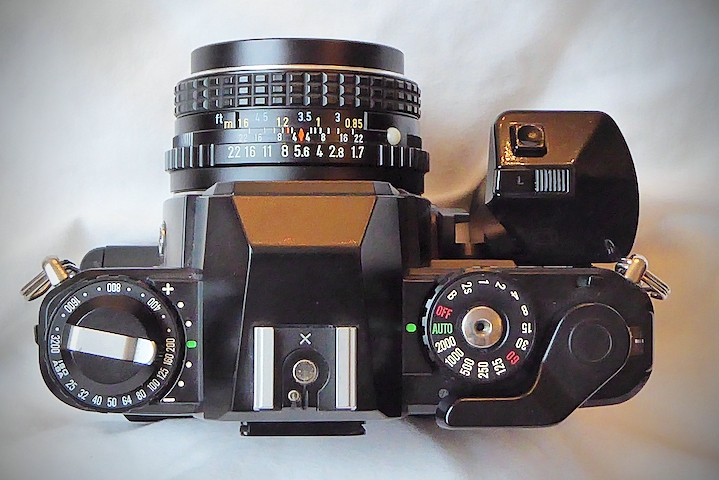
It’s not perfect, it’s mostly made of plastic, the body core is actually metal but it would be hard to know that from the exterior as almost all the external elements are plastic. Even the winder lever is plastic! Canon spoofed it with their plastic casings and used a copper base paint layer so the camera would ‘brass’ over time and appear to be made of metal, they also used a metal baseplate. Minolta used a similar trick with a brass undercoat but put a plastic ‘protector’ plate over the base to disguise the fact that it’s plastic. Chinon just shot from the hip and made it out of plastic and had done with it. That’s a real shame as the plastic fantastic vibe does make the camera feel cheap. The CE5 does feel a little more fragile in the hands especially with regards to its winder lever but that’s just a feeling rather than fact.
The biggest downside with Chinon is they are nigh impossible to repair. They were never a huge seller in the day in the UK so spares and expertise are hard to come by and in the CE-5s case its so heavily electronic any faults are likely to mean it’s a total loss. To be fair that’s no different with many electronic cameras from this period. Even Minoltas XD (regarded by many as the best MF camera ever made) can suffer catastrophic failure due to its ageing electronics.
Obviously being electronic the CE-5 needs batteries, but these are standard and readily available SR44 type which is nice as it means no messing about with battery conversions but it has no manual backup so without batteries your dead.
As a shooter the CE-5 I owned was a great grab and go camera. It was reliable and its meter accurate, it fitted easily in the hand and when kitted out with a motor drive was a good grippy camera. The simple and well laid out controls with a full information viewfinder make it an easy camera to live with.

A massive range of glass is readily available for it thanks to its Pentax K mount which lets you get on with almost any glass – you can even get a readily available K Mount to M42 adaptor to use older M42 lenses which are plentiful and cheap. I used some Chinon M42 mounted lenses with mine via a mount adaptor and found Chinon glass to be extremely good in the 50mm range. The lenses perform extremely well and are very well made using brass and aluminium construction when most manufacturers had moved to plastic. Equipped with a readily available and ludicrously inexpensive Pentax M series 50mm it’s both compact and light.
Kitted out with a Pentax M-Series lens my own CE-5 shot very well and with its range of features could outperform many cameras from the bigger brands. If only Chinon had made it with metal and not had the awful Dixons brand attached to it, I suspect this would have been a very serious competitor to the Canon AE-1 and the Minolta X-700 so beloved of the new generation of film fans.
Sadly, a last place hero thanks to its off brand name and its more glamorous rivals shining more brightly but, it’s definitely a star performer when it comes to value and functionality.
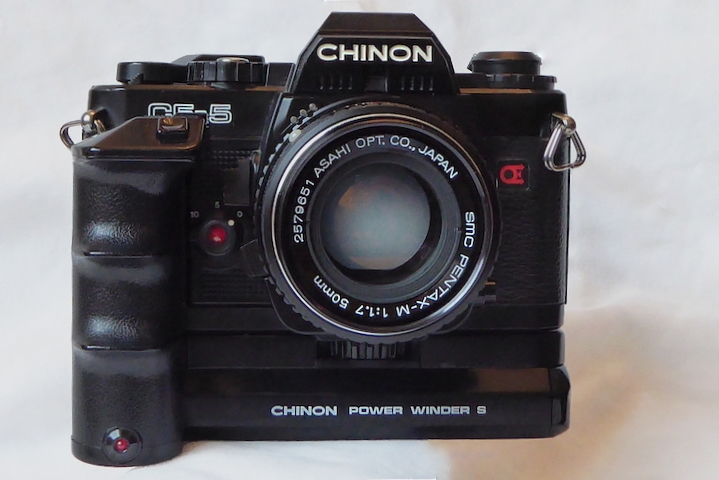
Further Reading
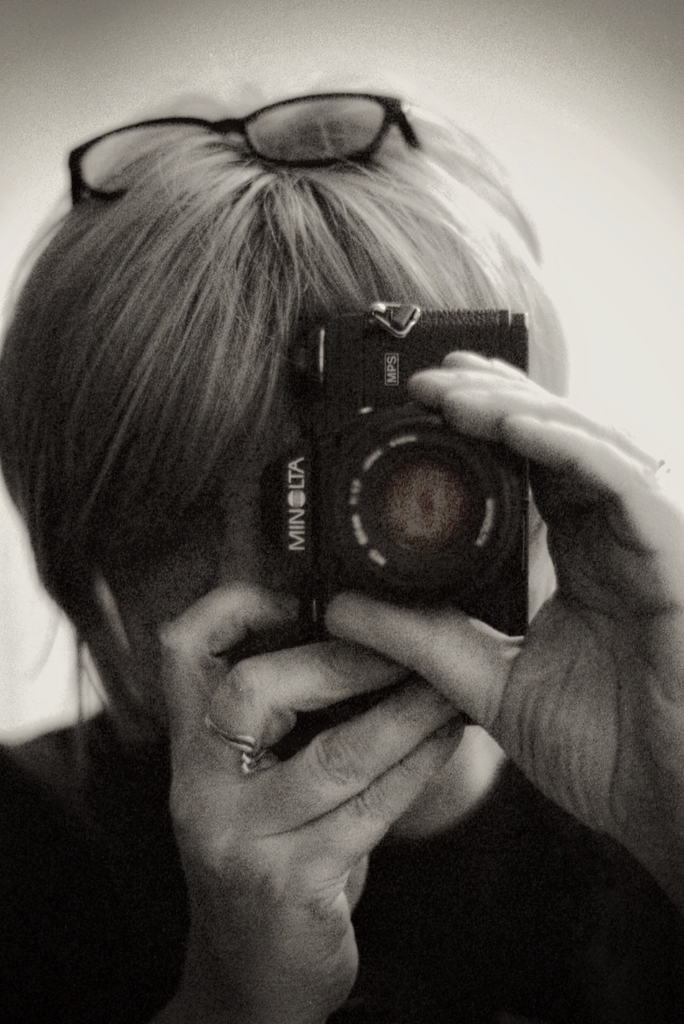
Mel is one of the driving forces behind High 5 Cameras and writes all our articles.
Starting serious photography back in 1972. Over the years she got to shoot film with most of the major brands in 35mm and large format as both a studio photographer and content provider for websites in the early life of the web. These days she is rediscovering photography and has become the GOTO person for knowledge on camera repair advice.


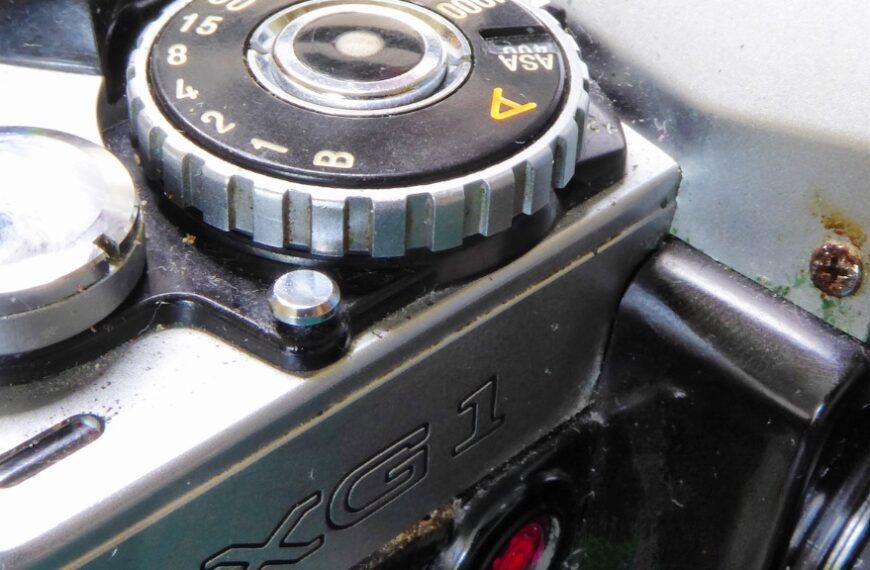
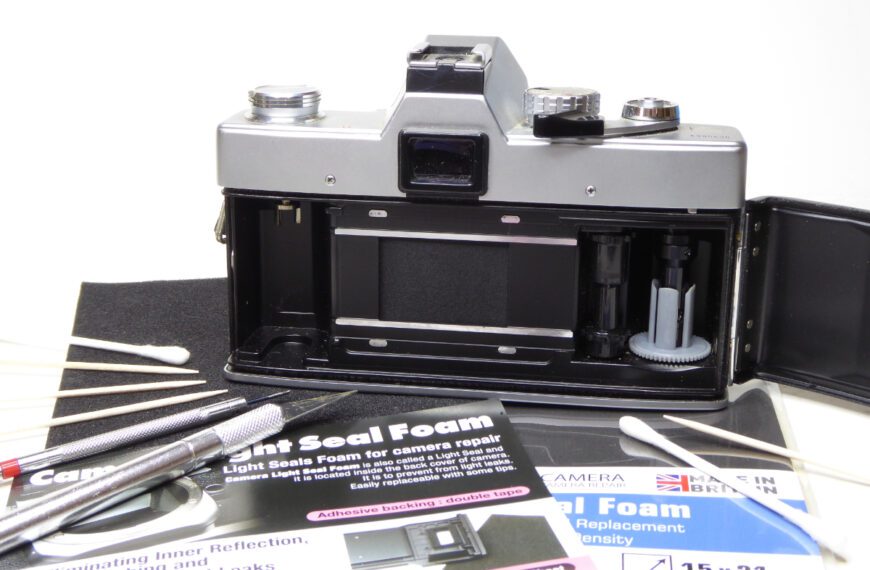
A very informative review of a great camera. I own 8 different Chinon SLRs dating from the early 70s first CE Memotron & CX range. This very reputable Japanese company produced highly spec’d products including Cine Cameras & Projectors, Slide Projectors, 35mm Compacts and even HI-Fi separates! All of which were good quality and much better value when compared to their better known rivals. Their return rate was no better or worse than these same rivals. How do I know this? Because I spent 30 years+ as a camera salesman, manager & finally regional manager in the same Dixons that you describe as ‘a high street chain with a reputation for goods of dubious quality and often shockingly cheap and shabby’. This is disappointing, and spoils your otherwise excellent and accurate review. Yes, Dixons did sell cheap and sometimes less good quality products, in line with similar retailers, but ALWAYS offered good deals on some VERY GOOD brands too. As a manager of Dixons’ flagship store in Glasgow in the 1980s I can tell you that we sold many thousands of SLRs from almost EVERY brand and although Chinon products offered a higher profit margin, it certainly didn’t stop us recommending other brands where they better suited the customer’s needs. Summary – Great review, but a shame to be so critical of Dixons, who undoubtedly brought 35mm photography to the masses!
Haha, just checking on the internet about the CE-5 as got one in the post today and what was the first review I came across. Thanks Mel. Mine was sold as parts and repair coming with the power winder which has batter corrosion, the Pentax P/K to M42 adapter and a Carl Zeiss Jena P 29mm f2.8 lens. All total for £37 including postage.
Once the winder was removed the first thing was to check the battery compartment and of course, there was a nice blue corroded battery on top. The second battery was still almost fully charged so once cleaned up and another battery put in, hey ho! It worked fine. I like the 4sec shutter speeds as I do a lot of slow shutter speed work so that gives a bit more play. Everything else is in good condition so the winder which I am not a fan of may get looked at or sold for parts and repair as who has the time these days when spring is around the corner. Looking forward to learning what the various levers are but I know that the big lever just below the speed dial is not in use with the adapter in place as there are no lugs to catch for depth of field preview. Anyway a film will be going in shortly for a play. Cheers
Glad you enjoyed the article and good to see you on the site…more articles coming soon 🙂
Mel
Hi
I am a big fan of Chinon. I have 2 CE-5s, 2 CG-5s, a CM-4s, a CA-4, 2 CP-7Ms, a CP-9, a CP-X, a CE, CE-II and CE-3 Memotron and a CM-7. Though the CM-7 is one of the Cosina variants, essentially the same camera as the Nikon FM-10. The CE-5 is one of my favourite cameras to use, and I have over 350 cameras.
Hi Steve,
Gosh that’s a lot of cameras – I seldom keep them for more than a few months. Once I have run them with some film, serviced them etc they are generally sold on – my aim is really to preserve some of these classics for the next generation.
What flash would be good for the CE-5. Bought my daughter this camera for her birthday but she would like to get a flash for it. I have come across the METZ MECABLITZ 24 AF-1 PENTAX – so you know if that will work and if it is a decent flash?
Hi Sandy,
A quick look on the internet tells me this will not work. The flashgun you mention appears to have a dedicated hot shoe. Later model cameras than your Chinon CE5 starting in the mid-90s started to employ dedicated shoes, these have a different contact layout on the shoe of the flash which could handle extra functions for later autofocus type cameras. Features like auto flash zoom, through the Lens Flash metering (TTL), flash ready indicator in the viewfinder etc etc.
The CE5 is a relatively old camera and only supports flash ready and, when coupled to the original Chinon flashgun, will automatically set the camera to its flash synch. speed of 1/60th.
Almost any old school flash would work but there may be modern alternatives for a simple flash. Just remember that there are three general classes of flash guns.
1/ Dumb flash – it just fires at full power all the time and you control the light by adjusting the exposure using the aperture on the camera. These normally have a table on the back of the flash that tell you what aperture setting to use dependent on range to the target. Heavy on batteries because the flash is running at full power the whole time – they also tend to be slow to charge up as the flash uses the entire stored power in one go.
2/ Auto Flash – the flash gun contains a sensor, you still need to set an aperture on the camera but only for a broad range (usually near to mid-distance or mid-distance to far distance – far distance will be dictated by the power of the flash gun but as far as 60′) the flash does the rest by using its sensor to detect when to cut off the power – these started to appear in the 70s and were quite a sea change. This would be the style designed for use with your CE5.
3/ TTL flash – this was the last generation and is still used today. The flash gun has connections to the cameras exposure metering system and the camera can control the power output of the flash from its one through the lens metering. Minolta pioneered this but its pretty much the standard today – it was improved further by Olympus with a system called OTF – Off The Film metering which allowed the meter reading to be taken from the actual film strip itself.
There is a link here you could look at – this is geared for digital cameras but the principle is the same https://digital-photography-school.com/understand-flash-settings-ttl-manual/
You should also be aware that the CE5 being fully electronic may be susceptible to risk because some old school 1970s flash guns employed very high trigger voltages. Basically, all the flash hot shoe on a camera does is short out a flash gun’s capacitors to unleash the power in them to drive the flash tube. Some 1970s and before flashguns can unleash upwards of 300 volts into the camera. That was fine with mechanical cameras but some electronic cameras don’t like it. I can’t say for the CE5.
When I used my CE5 I tended to use the Chinon dedicated flash for it – the Auto S-280 – I can’t speak for other flashguns but the Cobra flashguns are generally well regarded from that period. Avoid Vivitar because many of their flashguns from that period used monster voltages.
If you do a bit of research and use eBay you should find a flash gun at not too much cash – check that the battery contacts are clean as many have been left in people’s cupboards with decaying batteries. A good clean flash in working condition from the 1980s should cost so more than £30 tops.
Hope the above helped. If you found this of use please consider hitting the Buy us a Coffee icon above and well, buy us a coffee to say thanks as well as letting us know how you got on with sourcing a flash.
Kind Regards
Mel
The CE-5 kit lens was the 28-50mm macro. The “odd looking” electronic flash is a macro-flash to extend out over the lens.
I bought the CE-5 in 1980. It still works just fine.
Chinon were originally a lens manufacturer since 1948, now owned by Kodak Japan Ltd. Chinon’s best lenses can rival or better Asahi Pentax of the same period (you’ll notice if you swap the 28-50 for the Pentax version).
The CE-4 and CE-5 date from 1980 which is when Chinon switched to PK mount. Chinon PK mount lenses date from no earlier than this.
Hi Jeff,
Thanks for that we originally had a 28-50 on our own CE-5 but never really liked it that much. Ours spent most of its time with a Pentax M series lens. You are so right about the quality of Chinon glass. One of our earliest restore jobs was a pair of Chinon 50mm lenses which were is terrible condition from poor storage. They both came up beautiful and looking back we wish we hadn’t sold them on. They performed beautifully and were very solidly made, better construction in fact than most of the big 5 and all the more remarkable because they were from a period when Nikon, Pentax, Olympus, Minolta and Canon had moved to largely plastic construction.
Sadly some of the great makers of cameras and lenses just couldn’t survive – people like Chinon, Miranda, Topcon etc were relegated to their once proud brands being relegated to the brand name being used for cheap products.
I had several topcons great cameras they were,they closed their camera factory because of stiff competition,topcon are still in business they make optical equipment on most hospitals today